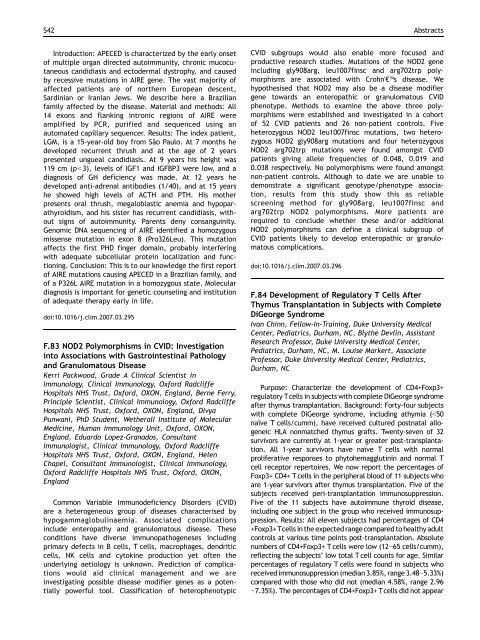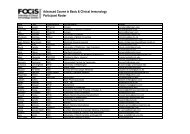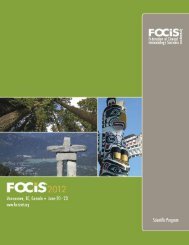Oral Presentations - Federation of Clinical Immunology Societies
Oral Presentations - Federation of Clinical Immunology Societies
Oral Presentations - Federation of Clinical Immunology Societies
You also want an ePaper? Increase the reach of your titles
YUMPU automatically turns print PDFs into web optimized ePapers that Google loves.
S42 Abstracts<br />
Introduction: APECED is characterized by the early onset<br />
<strong>of</strong> multiple organ directed autoimmunity, chronic mucocutaneous<br />
candidiasis and ectodermal dystrophy, and caused<br />
by recessive mutations in AIRE gene. The vast majority <strong>of</strong><br />
affected patients are <strong>of</strong> northern European descent,<br />
Sardinian or Iranian Jews. We describe here a Brazilian<br />
family affected by the disease. Material and methods: All<br />
14 exons and flanking intronic regions <strong>of</strong> AIRE were<br />
amplified by PCR, purified and sequenced using an<br />
automated capillary sequencer. Results: The index patient,<br />
LGM, is a 15-year-old boy from São Paulo. At 7 months he<br />
developed recurrent thrush and at the age <strong>of</strong> 2 years<br />
presented ungueal candidiasis. At 9 years his height was<br />
119 cm (pb3), levels <strong>of</strong> IGF1 and IGFBP3 were low, and a<br />
diagnosis <strong>of</strong> GH deficiency was made. At 12 years he<br />
developed anti-adrenal antibodies (1/40), and at 15 years<br />
he showed high levels <strong>of</strong> ACTH and PTH. His mother<br />
presents oral thrush, megaloblastic anemia and hypoparathyroidism,<br />
and his sister has recurrent candidiasis, without<br />
signs <strong>of</strong> autoimmunity. Parents deny consanguinity.<br />
Genomic DNA sequencing <strong>of</strong> AIRE identified a homozygous<br />
missense mutation in exon 8 (Pro326Leu). This mutation<br />
affects the first PHD finger domain, probably interfering<br />
with adequate subcellular protein localization and functioning.<br />
Conclusion: This is to our knowledge the first report<br />
<strong>of</strong> AIRE mutations causing APECED in a Brazilian family, and<br />
<strong>of</strong> a P326L AIRE mutation in a homozygous state. Molecular<br />
diagnosis is important for genetic counseling and institution<br />
<strong>of</strong> adequate therapy early in life.<br />
doi:10.1016/j.clim.2007.03.295<br />
F.83 NOD2 Polymorphisms in CVID: Investigation<br />
into Associations with Gastrointestinal Pathology<br />
and Granulomatous Disease<br />
Kerri Packwood, Grade A <strong>Clinical</strong> Scientist in<br />
<strong>Immunology</strong>, <strong>Clinical</strong> <strong>Immunology</strong>, Oxford Radcliffe<br />
Hospitals NHS Trust, Oxford, OXON, England, Berne Ferry,<br />
Principle Scientist, <strong>Clinical</strong> <strong>Immunology</strong>, Oxford Radcliffe<br />
Hospitals NHS Trust, Oxford, OXON, England, Divya<br />
Punwani, PhD Student, Wetherall Institute <strong>of</strong> Molecular<br />
Medicine, Human <strong>Immunology</strong> Unit, Oxford, OXON,<br />
England, Eduardo Lopez-Granados, Consultant<br />
Immunologist, <strong>Clinical</strong> <strong>Immunology</strong>, Oxford Radcliffe<br />
Hospitals NHS Trust, Oxford, OXON, England, Helen<br />
Chapel, Consultant Immunologist, <strong>Clinical</strong> <strong>Immunology</strong>,<br />
Oxford Radcliffe Hospitals NHS Trust, Oxford, OXON,<br />
England<br />
Common Variable Immunodeficiency Disorders (CVID)<br />
are a heterogeneous group <strong>of</strong> diseases characterised by<br />
hypogammaglobulinaemia. Associated complications<br />
include enteropathy and granulomatous disease. These<br />
conditions have diverse immunopathogeneses including<br />
primary defects in B cells, T cells, macrophages, dendritic<br />
cells, NK cells and cytokine production yet <strong>of</strong>ten the<br />
underlying aetiology is unknown. Prediction <strong>of</strong> complications<br />
would aid clinical management and we are<br />
investigating possible disease modifier genes as a potentially<br />
powerful tool. Classification <strong>of</strong> heterophenotypic<br />
CVID subgroups would also enable more focused and<br />
productive research studies. Mutations <strong>of</strong> the NOD2 gene<br />
including gly908arg, leu1007finsc and arg702trp polymorphisms<br />
are associated with Crohn'€s disease. We<br />
hypothesised that NOD2 may also be a disease modifier<br />
gene towards an enteropathic or granulomatous CVID<br />
phenotype. Methods to examine the above three polymorphisms<br />
were established and investigated in a cohort<br />
<strong>of</strong> 52 CVID patients and 26 non-patient controls. Five<br />
heterozygous NOD2 leu1007finsc mutations, two heterozygous<br />
NOD2 gly908arg mutations and four heterozygous<br />
NOD2 arg702trp mutations were found amongst CVID<br />
patients giving allele frequencies <strong>of</strong> 0.048, 0.019 and<br />
0.038 respectively. No polymorphisms were found amongst<br />
non-patient controls. Although to date we are unable to<br />
demonstrate a significant genotype/phenotype association,<br />
results from this study show this as reliable<br />
screening method for gly908arg, leu1007finsc and<br />
arg702trp NOD2 polymorphisms. More patients are<br />
required to conclude whether these and/or additional<br />
NOD2 polymorphisms can define a clinical subgroup <strong>of</strong><br />
CVID patients likely to develop enteropathic or granulomatous<br />
complications.<br />
doi:10.1016/j.clim.2007.03.296<br />
F.84 Development <strong>of</strong> Regulatory T Cells After<br />
Thymus Transplantation in Subjects with Complete<br />
DiGeorge Syndrome<br />
Ivan Chinn, Fellow-In-Training, Duke University Medical<br />
Center, Pediatrics, Durham, NC, Blythe Devlin, Assistant<br />
Research Pr<strong>of</strong>essor, Duke University Medical Center,<br />
Pediatrics, Durham, NC, M. Louise Markert, Associate<br />
Pr<strong>of</strong>essor, Duke University Medical Center, Pediatrics,<br />
Durham, NC<br />
Purpose: Characterize the development <strong>of</strong> CD4+Foxp3+<br />
regulatory Tcells in subjects with complete DiGeorge syndrome<br />
after thymus transplantation. Background: Forty-four subjects<br />
with complete DiGeorge syndrome, including athymia (b50<br />
naïveTcells/cumm),havereceivedculturedpostnatalallogeneic<br />
HLA nonmatched thymus grafts. Twenty-seven <strong>of</strong> 32<br />
survivors are currently at 1-year or greater post-transplantation.<br />
All 1-year survivors have naïve T cells with normal<br />
proliferative responses to phytohemagglutinin and normal T<br />
cell receptor repertoires. We now report the percentages <strong>of</strong><br />
Foxp3+ CD4+ T cells in the peripheral blood <strong>of</strong> 11 subjects who<br />
are 1-year survivors after thymus transplantation. Five <strong>of</strong> the<br />
subjects received peri-transplantation immunosuppression.<br />
Five <strong>of</strong> the 11 subjects have autoimmune thyroid disease,<br />
including one subject in the group who received immunosuppression.<br />
Results: All eleven subjects had percentages <strong>of</strong> CD4<br />
+Foxp3+ Tcells in the expected range compared to healthy adult<br />
controls at various time points post-transplantation. Absolute<br />
numbers <strong>of</strong> CD4+Foxp3+ T cells were low (12−65 cells/cumm),<br />
reflecting the subjects’ low total T cell counts for age. Similar<br />
percentages <strong>of</strong> regulatory T cells were found in subjects who<br />
received immunosuppression (median 3.85%, range 3.48−5.33%)<br />
compared with those who did not (median 4.58%, range 2.96<br />
−7.35%). The percentages <strong>of</strong> CD4+Foxp3+ Tcells did not appear




